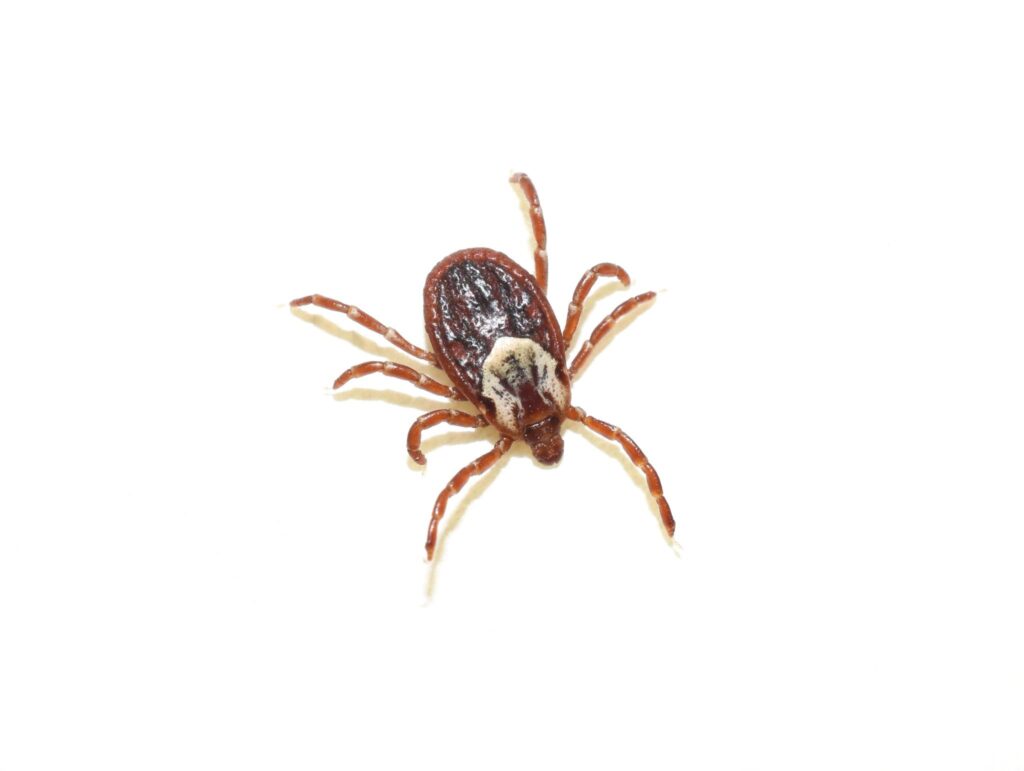Just in time for fall, we introduce another bloodsucking tick. The American Dog Tick, also known as a Wood Tick, lives near water sources, such as rivers, streams, creeks and lakes. These ticks often attach themselves to mammals such as deer, raccoons and others who are enjoying a refreshing drink. However, despite their natural habitat of living near water, in the woods, they can survive indoors for up to two or three years.
Lifecycle
The American Dog Tick requires a blood meal at each stage of life in order to grow and live, and females must engorge themselves in order to gain enough nutrients to produce and lay between 4,000 to 7,000 eggs. Rest assured that not the eggs will make it to maturity.
Meals
Two to three years is the amount of time American Dog Ticks can live without a meal. Larvae typically feed on small rodents, such as mice or rats, but older American Dog Ticks are more likely to attach themselves to larger mammals, including humans. Unlike other tick species, these do not embed their entire head into the host, but only the mouth. Depending on the tick’s life stage, it can feed off the host for hours to days.
Diseases
Similar to other tick species, they inject their host with an anti-clogging agent that prevents the blood from clotting. Bites from the American dog tick, along with other closely related species, can sometimes cause a severe reaction called tick bite paralysis. This only occurs in a relatively small number of people, but they can also transmit more common diseases such as Lyme disease and Rocky Mountain Spotted Fever.
Humans who develop a reddish rash around the site of a tick bite, suffer arthritis-like pain in one or more joints or have flu-like symptoms that come and go after recently being bitten by a tick, should seek medical attention. Many people associate ticks with Lyme disease. The migrating, bulls-eye rash is a key symptom of Lyme disease and occurs in about 60 percent of people contracting the disease. Anyone with this type of rash should speak to a medical professional to be checked for Lyme disease or other potential illnesses.
Control and Prevention for the American Dog Ticks
Ticks can be difficult to control, therefore the services of an experienced pest management company, such as United Pest & Turf Control are recommended. Treatments may be necessary in wooded, high grass or wetland-type areas of a property, as well as near water features.
For people who choose to go hiking, hunting or just hang out near the woods, it’s important to follow these tips to reduce the chance of a tick bite or bringing one home:
- Wear long-sleeved shirts and long pants. Light colors are best so ticks are easier to detect.
- Secure the bottom of pants inside socks or tie them closed around the ankles.
- Wear a hat and tuck long hair under it so ticks do not hitchhike.
- Use tick repellent applied to clothing, particularly the lower body and the arms.
- Carefully inspect your body after exiting infested areas. Have another person inspect your backside and the back of your head.
- Never throw potentially infested clothing in a hamper with other clothes or onto the floor. Wash them immediately in warm water and detergent.
- Protect pets by preventing them from venturing into tick-infested areas or consult your veterinarian for tick treatment products. Dogs can also contract Lyme Disease.
- Inspect pets carefully for ticks after walking them in wooded areas or fields.
- To remove an embedded tick, use fine-tipped tweezers, grasp the tick by the head and slowly pull it backward.
- Do not grasp a tick by the abdomen and pull. You may squeeze its fluids into your skin, which increases the chances of infection.
- Once the tick has been removed, cleanse the area well with soap and water. You may want to disinfect the bite site with alcohol or apply an antibiotic cream.
The American Dog Tick in North Alabama and Southern Tennessee
Serving North Central Alabama and South Central Tennessee
Limestone County
Ardmore
Home » The American Dog Tick


